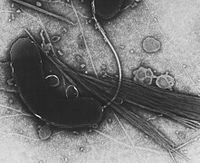
Photo from wikipedia
Natural organic matter (NOM) can influence the toxicity and speciation of chromium (Cr) in subsurface through redox reactions and complexation. Under anoxic conditions, NOM can be reduced by microorganisms or… Click to show full abstract
Natural organic matter (NOM) can influence the toxicity and speciation of chromium (Cr) in subsurface through redox reactions and complexation. Under anoxic conditions, NOM can be reduced by microorganisms or geochemical reductants, and the reduced NOM (NOMred) represents a large reservoir of organic matter observed in anoxic sediments and water. While the current body of work has established the kinetic of Cr(VI) reduction by oxidized NOM (NOMox) under oxic conditions, much less is known about the rates and mechanisms of Cr(VI) reduction triggered by NOMred under anoxic conditions and the colloidal properties of the reaction products. This study provided new information regarding the NOMred-mediated Cr(VI) reduction and colloidal stability of reduced Cr(III) particles over a wide range of environmentally relevant anoxic conditions. We show that under dark anoxic conditions reduced humic acid (HAred) moieties (e.g., quinone) can quickly reduce Cr(VI) to Cr(III), and the reduced Cr(III) can subsequently complex with carboxyl groups of HA leading to the formation of stable HA-Cr(III) colloids. Rates of Cr(VI) reduction by HAred are 3-4 orders of magnitude higher than those by oxidized HA (HAox) due primarily to the higher reducing capacity of HAred. The stable HA-Cr(III) colloids are formed across a range of HA concentrations (8-150 mg C/L) and pH conditions (6-10) with hydrodynamic diameter in the range of 210-240 nm. Aberration-corrected scanning transmission electron microscopy (Cs-STEM) and X-ray photoelectron spectroscopy (XPS) confirmed that the particles are composed of HA-Cr(III). The high colloidal stability of HA-Cr(III) particles could be attributed to the enhanced electrosteric stabilization effect from free and adsorbed HA, which decreased particle aggregation. However, the presence of divalent cations (Ca2+ and Mg2+) promoted particle aggregation at pH 6. These new findings are valuable for our fundamental understanding of the fate and transport of Cr in organic-rich anoxic environments, which also have substantial implications for the development and optimization of subsurface Cr sequestration technology.
Journal Title: Water research
Year Published: 2020
Link to full text (if available)
Share on Social Media: Sign Up to like & get
recommendations!